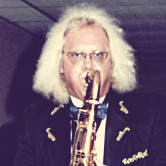Santy Runyon Discusses Reeds
By Santy Runyon
(The following article is a collection of four letters from my good friend and mouthpiece manufacturer Santy Runyon. These letters give insight into reeds, their history and manufacture in the U. S., effects on the embouchure, selection of reeds, and other tips.—Paul Coats)
Part 1 (From a two part letter from Santy Runyon)
Just a few experiences with materials, design, methods of manufacture, etc etc.
I played drums for silent pictures, before “talkies” came out. I started at the age of eight. Bill Ludwig, of the Selmer Co., and I are the only “trap drummers” left. That’s what Bill told me the last time I saw him. When a bird appeared on the silent screen, it was the job of the drummer to blow a little bird whistle. You had to have a train whistle when an old coal operated train appeared. A cow moo, you would blow when the farmer was milking the cow. A big sheet of tin with a handle on it would sound like thunder—you would shake it when rain appeared on the screen. Pull the trigger on a cap pistol when the cowboy would shoot an Indian. Couldn’t get fired cause my ol’ man owned the show. This was in Barnsdall, Oklahoma, a small town in Osage Indian Territory. I did this until “talkies” came out.
When I was ten, my father bought me a C Melody Sax. It was used and it came with one reed. It played pretty good, and I learned to play two tunes on it in two days. I had already played Vibes for a couple of years, so I did know a little about music.
I was very enthused about Sax and played it a lot, so you can imagine what happened to that one reed. This town was 45 miles from Tulsa–so I was out of luck for a reed. Radio was invented just a couple of years before. The front panel was made of hard rubber, and my dad had broken it and the hard rubber panel was in pieces. Our picture machine operator saw my plight so he whittled out a hard rubber reed–patterned it after the worn out cane reed. He and I fooled with it until we got it to play pretty good. I played that reed for almost nine months, until I got a chance to go to Jenkins Music Store in Tulsa. I bought six # 2 1/2 reeds. Every one was different. One was so hard I couldn’t play it–one so soft it was almost useless. I had to rework every one of those reeds. That is still going on today. You buy five reeds and they are all different, no matter what brand you select.
I have said this many times–I played lead alto and principle flute in the Chicago Theatre Orchestra for eleven years (1931-1942). Playing 5 to 7 shows a day plus three early morning rehearsals a week, you had better have some chops, and you had better keep ‘em up. Reed management was my means of keeping the embouchure in shape.
Part 2 (The reed and embouchure)
The afore mentioned cane reed that came with the C Melody sax is a good example of how too soft a reed can weaken your embouchure. The homemade hard rubber reed, on the other hand, is a great example of how you can maintain a consistent strength of the lips, since the reed didn’t weaken appreciably over a period of time. The only drawback, however, was the tone quality, which left a lot to be desired. Gale Stout, Vic Bowen (also of the Chicago Theatre Orchestra), and I devised a practical way to sustain a good embouchure.
We each bought a bunch of reeds. I bought about 50. Then, a clarinet reed cost 10 cents—alto, 15 cents—tenor, 20 cents. It would be prohibitive at today’s prices to do that. The object was to find five reeds of a good enough strength and quality to play the job in a satisfactory manner–strong enough to support the higher register, yet flexible enough to permit satisfactory attack on the low notes. We played those five reeds over and over until we were satisfied that any one of them would do this most important job. We would play one on the job for a week or ten days, depending on how the reed would hold up. Then start a reed session, playing those 4 remaining reeds. If, at the start of the reed session, that first reed seemed stiff–that was a dead giveaway. Sure enough the embouchure had weakened. After playing all four of the reserve reeds, the lips had gained their strength back. That really worked like a charm for us. We felt it necessary to always have four of the proper reeds in reserve. Most naturally, the discarded reed would always be replaced. The process served me well for eleven years.
Part 3 (Reed manufacturing)
It might be good to understand a little about how reeds are made. A gentleman by the name of Roy Maier and another named Tony Ciccone, both from Chicago, started the reed company presently known as the “Rico Company”. Tony dropped out of the picture, which left Roy as sole owner. Roy brought reeds to me at the Chicago Theatre, for me to test. They were then called Symmetricut reeds. Maybe I didn’t spell it right. The reeds were very good. Jimmy Dorsey heard me playing them and inquired about them. I gave him a couple and he liked them also. Maurie Berlin owned the Chicago Musical Instrument Company at that time, and to my knowledge he was the first distributor of Roy Maier’s Rico reeds. I arranged for Jimmy Dorsey to give an endorsement on the reed for the Chicago Instrument Company.
Years later, because I knew Roy that well, I was able to go through the Rico factory, and observed the process in making the reeds. The vamp on the reed is extremely thin at the tip. First cut (leaving the reed the longest and the thinnest) makes the 1-1/2 (the softest). It is then cut a little shorter for a #2. Then it is cut shorter again for a 2-1/2. As the reed is cut shorter and shorter, it becomes thicker and thicker, and as it becomes thicker and thicker, it also becomes harder and harder to attack the low notes.
Band directors all over the country tell the students to use 3-1/2 reeds, many times not knowing whether the mouthpiece that the student is using is close, medium, or open. If the mouthpiece is close, the 3-1/2 reed will probably work O. K., but that still doesn’t eliminate the fact that the reed is perhaps pretty thick at the tip. A 2-1/2 reed on a medium facing mouthpiece would produce better results for the average student.
Here is a kid with an open mouthpiece–he doesn’t know that it’s too open for him, and it’s possible that his band director doesn’t know it either. He is told to go and buy a 3-1/2 reed. What is he going to do now? If the band director knows mouthpieces, and has gauges (and a number of them are that well equipped) the kid is in good shape. The problem can be taken care of.
Roy Maier died a few years ago. Rico is now owned by Boosey & Hawkes, the same company that owns Buffet and Keilwerth.
Part 4 (From another letter, placing the reed on the mouthpiece)
Getting back to putting the reed on the mouthpiece in the right way–I had mentioned that the larger the facing the farther over the tip of the mouthpiece the reed should be placed to compensate for the shortening of the reed that occurs as the reed follows the curve of the mouthpiece facing. If the reed (when you press it down) covers the entire tip rail, you will observe that the tone becomes clearer and more solid–even a little darker. In turning the mouthpiece around (looking at the top of the mouthpiece), and pressing the reed down with the finger, you should see a miniscule hairline of the reed sticking out. It also tells you if the tip of the mouthpiece has been shaped to fit the contour of the reed properly. However, the tips of the reeds are not all the same, so it really doesn’t matter as long as the reed covers the entire tip rail. If it only covers a tiny amount of the tip rail–result–squeaks, no doubt.
Sincerely,
Santy Runyon
Santy Runyon is now 94 years old. Most people his age would have retired long ago, but Santy continues to head his company, Runyon Products, and develop new mouthpieces and accessories for woodwind players. He stays active giving lessons and clinics, playing gigs, and sometimes finds time for fishing.


